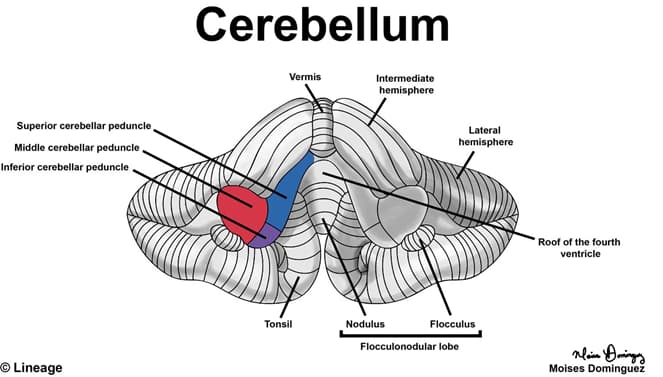Overview

Introduction
- Function
- to smoothly coordinate movement
- to play a role in motor planning and balance
- Anatomy
- the cerebellum is derived from the metencephalon and is found
- dorsally to the pons and rostral medulla which are attached by cerebellar peduncles
- between the cerebellum and this portion of the brainstem you will find the
- fourth ventricle
- between the cerebellum and this portion of the brainstem you will find the
- dorsally to the pons and rostral medulla which are attached by cerebellar peduncles
- the cerebellum contains
- the vermis and flocculonodular lobes which play an important role in
- proximal and truncal muscle control (vermis)
- vestibulo-ocular control (flocculonodular lobes)
- cerebellar hemisphere can be divided into
- intermediate hemisphere which plays an important role in
- distal appendicular muscle control
- lateral hemisphere which plays an important role in
- motor planning
- intermediate hemisphere which plays an important role in
- cerebellar peduncles
- superior cerebellar peduncles
- mainly carries output signals
- middle and inferior cerebellar peduncles
- mainly carries input signals to the cerebellum
- superior cerebellar peduncles
- the vermis and flocculonodular lobes which play an important role in
- deep cerebellar nuclei can be arranged from lateral → medial as
- Dendate nuclei
- Eboliform
- Globos
- Fastigial
- mnemonic: “Dont Eat Greasy Food”
- the cerebellum is derived from the metencephalon and is found
- Circuitry
- input
- brain (via the pontocerebellar and climbing fiber) to the cerebellum via the
- middle cerebellar peduncle
- spinal cord (via the spinocerebellar and climbing fibers) to the cerebellum via the
- inferior cerebellar peduncle (there are exceptions)
- vestibular system to the cerebellum via
- juxtarestiform body (in the inferior cerebellar peduncle)
- brain (via the pontocerebellar and climbing fiber) to the cerebellum via the
- output
- all cerebellar outputs are carried by Purkinje cells which synapse in the
- deep cerebellar nuclei or vestibular nuclei
- which deep cerebellar nuclei the Purkinje cell synapse with is dependent on where the Purkinje cell arose from
- Purkinje cells from
- lateral cerebellum synapse to the dendate nucleus which
- exits the cerebellum via the superior cerebellar peduncle → contralateral VL of the thalamus → motor cortex and supplementary motor areas to influence the corticospinal system for motor planning
- intermediate cerebellum synapses to the eboliform and globose nucleus
- exits the cerebellum via the superior cerebllar pendcuncle → contralateral VL of the thalamus → motor cortex and supplementary motor areas to influence the lateral corticospinal tract
- vermis synapses to the fastigial nucleus
- eventually influencing the medial motor system
- flocculonodular lobe synapses to the vestibular nucleus
- eventually leading to vestibulo-ocular control
- lateral cerebellum synapse to the dendate nucleus which
- Purkinje cells from
- which deep cerebellar nuclei the Purkinje cell synapse with is dependent on where the Purkinje cell arose from
- deep cerebellar nuclei or vestibular nuclei
- all cerebellar outputs are carried by Purkinje cells which synapse in the
- input
- Clinical correlate
- Physical exam
- physical exam maneuvers to test the cerebellum include
- finger-to-nose and heel-to-shin test
- finger tapping
- rapid alternating movement
- gait testing
- truncal ataxia can present with
- a wide-based and unsteady gait
- truncal ataxia can present with
- testing for ocular dysmetria and nyastagmus
- physical exam maneuvers to test the cerebellum include



